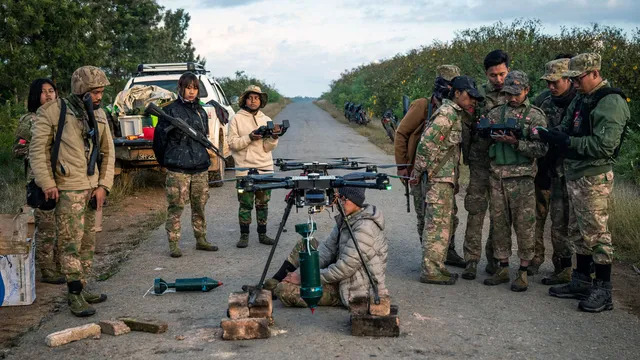
Myanmar junta gains territory using drone warfare strategy
2025-03-27 00:00- Myanmar's ruling junta has made recent territorial gains in Shan state after a series of military setbacks.
- The Tatmadaw used drone technology to enhance their artillery effectiveness, targeting rebel positions.
- Despite this achievement, experts doubt that the use of drones will significantly alter the civil war's outcome.
Express your sentiment!
Insights
In Myanmar, a country grappling with civil war since 2021, the ruling junta has recently made a significant advancement in its military campaign. This change marks the first territorial gains for the armed forces, known as the Tatmadaw, within Shan state since 2023. The Tatmadaw successfully recaptured enemy camps near the village of Tawung Hkam, strategically positioned to overlook Mandalay, which is Myanmar's second-largest city. This operation reversed a series of military failures the junta had faced in prior years. the key factor in this recent success was the innovative deployment of drone technology. The junta utilized bulky quadcopter drones to enhance its artillery capabilities. Footage from the battlefield showcased these drones directing an intense barrage of artillery and mortar strikes against rebel positions. This technological advancement provided the Tatmadaw with a modern edge in a conflict that had previously been characterized by setbacks and defeats. Despite this recent success, analysts express skepticism regarding the long-term implications of drone warfare in the ongoing conflict. The change in tactics may not guarantee a decisive shift in the broader war, which has drawn in a multitude of armed insurgent groups opposing the junta. The situation remains complex and fluid, with various variables influencing both the short-term outcomes and the overall course of the civil war. In a broader context, the use of drones in military operations has been increasingly scrutinized worldwide, raising ethical concerns about warfare tactics and their impact on civilians. As Myanmar's junta embraces this technology, the effectiveness of drones on the battlefield will continue to be a critical area of observation, particularly in how it shapes the dynamics of conflict moving forward.
Contexts
The history of the civil war in Myanmar, also known as Burma, is a complex narrative that spans several decades, marked by ethnic tensions, political struggles, and the quest for autonomy. The civil war initially ignited in 1948, shortly after the country's independence from British colonial rule, when various ethnic groups started to demand greater rights and autonomy. The civil war has since evolved into a multi-faceted conflict involving numerous ethnic armed groups, the military government, and various political factions. The military junta has been particularly notorious for its brutal repression of dissent and its efforts to maintain control over the diverse regions of the country, contributing to ongoing violence and instability. Throughout the 20th and into the 21st century, Myanmar's civil war has seen the emergence of several notable ethnic groups, such as the Karen, Shan, and Kachin, each pursuing their own aspirations for self-determination and representation. The central Burman government has historically marginalized these ethnic minorities, leading to widespread resentment and armed resistance. A pivotal moment came in 2011 when Myanmar began a process of nominal political reform, which included peace talks with various ethnic groups. However, the transition to a more democratic system has remained fraught with challenges, often giving rise to renewed violence as the military continues to see ethnic armed groups as a threat to its authority. The situation further deteriorated in February 2021, following the military coup that ousted democratically elected leader Aung San Suu Kyi. This event reignited the civil war, as pro-democracy forces and ethnic armed organizations began to unite against the military regime. The coup prompted mass protests, which were met with brutal crackdowns by the military, leading to significant civilian casualties and widespread displacement. International condemnation followed, with calls for sanctions and humanitarian assistance, as the conflict exacerbated an already dire humanitarian crisis in the country. Meanwhile, various ethnic groups have continued to mobilize both to defend their territories and to challenge the legitimacy of the military rule. As of now, the civil war in Myanmar remains unresolved and is characterized by a fragmentation of alliances and a lack of cohesive strategies among various factions. Peace negotiations appear to be stalled, with each side holding entrenched positions. The ongoing conflict has dire implications, not only for Myanmar's internal stability but also for the wider Southeast Asian region, as the influx of refugees and the potential for regional instability pose significant challenges. The international community's engagement has been inconsistent, reflecting geopolitical interests and the complexities of the conflict. Moving forward, addressing the root causes of the civil war, promoting inclusive dialogue, and fostering a genuine democratic process are essential for any long-term resolution in Myanmar.